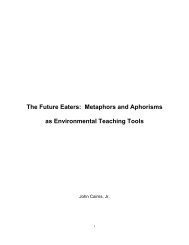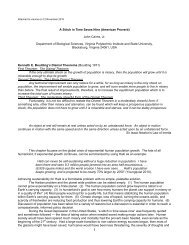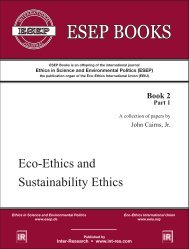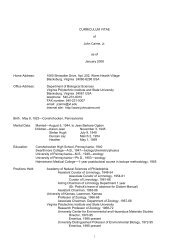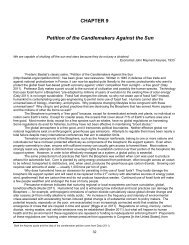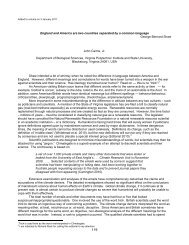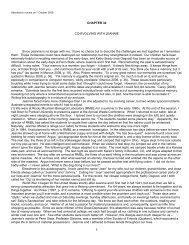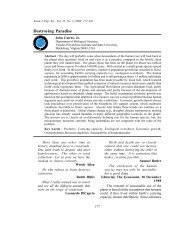View - ResearchGate
View - ResearchGate
View - ResearchGate
You also want an ePaper? Increase the reach of your titles
YUMPU automatically turns print PDFs into web optimized ePapers that Google loves.
254Cairns: Eco-Ethics and Sustainability Ethicscould help with carrying capacity problems, it would be foolish to expect assistance, at present,from outside Earth’s solar system.Humankind may have already passed the planet’s long-term carrying capacity for humans sincenatural capital is being used more rapidly than it is being replaced. Even if this limit has not beenreached, continued exponential growth of both population and rate of resource consumption ensuresthat humankind will soon reach or exceed it. Although the scale for Earth is much larger than inthe two islands, the basic issues are quite similar.EASTER ISLANDThe lesson from Easter Island has been discussed in detail in a variety of both popular and academicpublications as well as on television (e.g. Flenly et al. 2003). Diamond (1994) has presented aconcise discussion of the ecological collapse of ancient civilizations, including Easter Island.Basically, the inhabitants of Easter Island exceeded their carrying capacity by over-harvestingtrees that covered the island when it was colonized about 400 AD. Forests were cleared for agriculture,construction of canoes, and for the transport and leverage of the huge statues for whichthe island is renowned. The statues were moved several miles from the quarry to the coastal area,even though they weighed as much as 80 tons and were up to 37 feet tall. Clearly, the civilizationof Easter Island was well organized in order to achieve the remarkable feat of erecting thesestatues.Easter Island’s peak population appears to have been reached in 1500 AD at 7,000 individuals orapproximately 150 per square mile. By this time, about 1,000 statues had been carved and 324erected. Deforestation resulted in the inability to make large canoes, thus effectively cutting offaccess to any marine fishery in deep water. Additionally, erosion resulted from the loss of foreststhat held soil in place and eventually depleted the terrestrial food resources, which led to resourcewars and a population collapse. The inhabitants continued unsustainable practices despiteevidence they were not sound. Alternatively, they may have realized the drawbacks of living unsustainablyafter it was too late to make a mid-course correction. An eventual population reduction toan estimated one-third of its peak level illustrates that the cost of exceeding carrying capacity isnot trivial.These events are even more poignant because the inhabitants no longer had the means to buildthe large canoes they needed for escape. Similarly, if Earth is regarded as an island in the galaxy,humankind currently does not have the means to escape, even if a refuge in the universe were available.In addition, transporting billions of people would pose a logistical nightmare.TIKOPIAThe inhabitants of Tikopia Island also exceeded their carrying capacity (Firth 1983, Kirsch2000), but took effective measures between 1000 and 1800 AD to stabilize their population atapproximately 1,281 to 1,323 people. They accomplished their goal by infanticide, abortion, anddecreeing that only first-born sons could have children. In addition, the inhabitants shifted tosustainable agriculture from ‘slash and burn’ practices. Finally, they eliminated pigs, despite thevalue Polynesians placed on them, because they damaged gardens and ate food the Tikopianscould consume.The precise processes that produced the dramatically different results for the two islands are notentirely clear. However, it is evident that the Tikopians better understood the concept of carrying capacityand that they possessed the leadership and will to achieve both a relatively stable population



